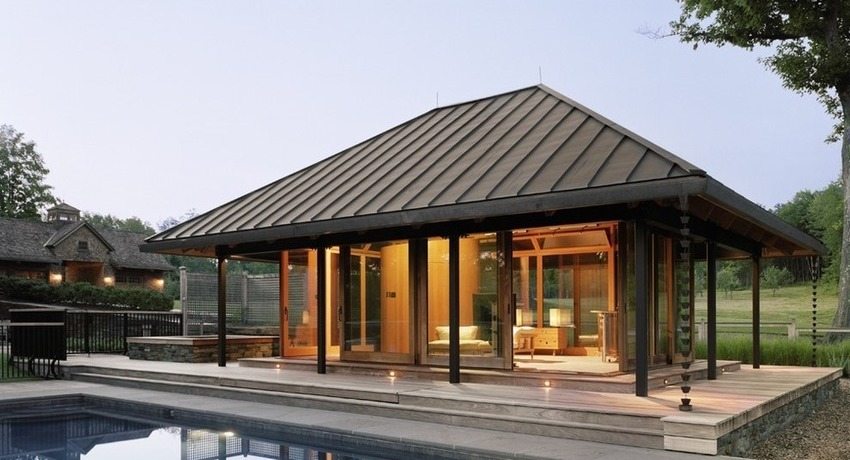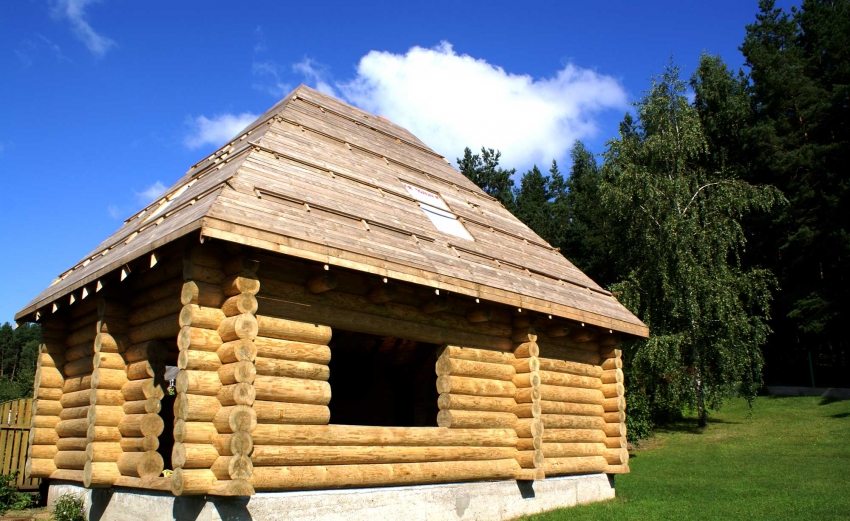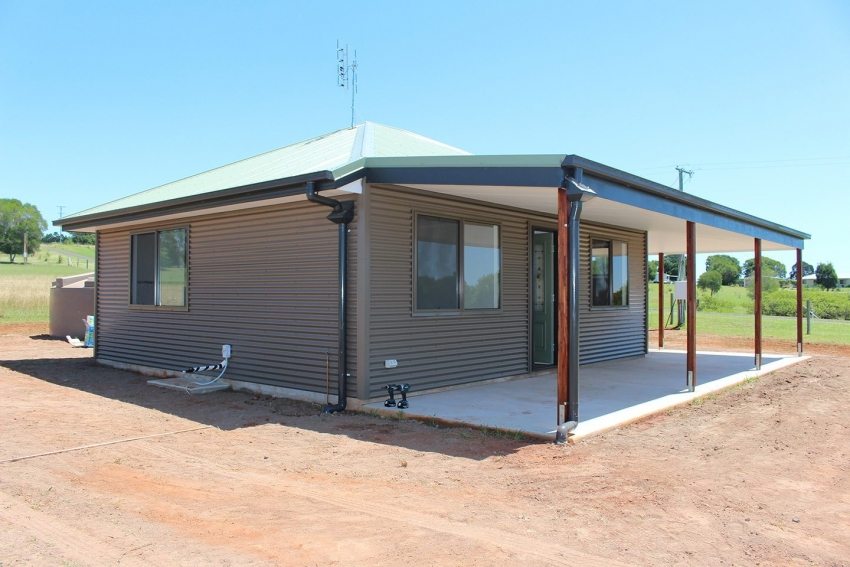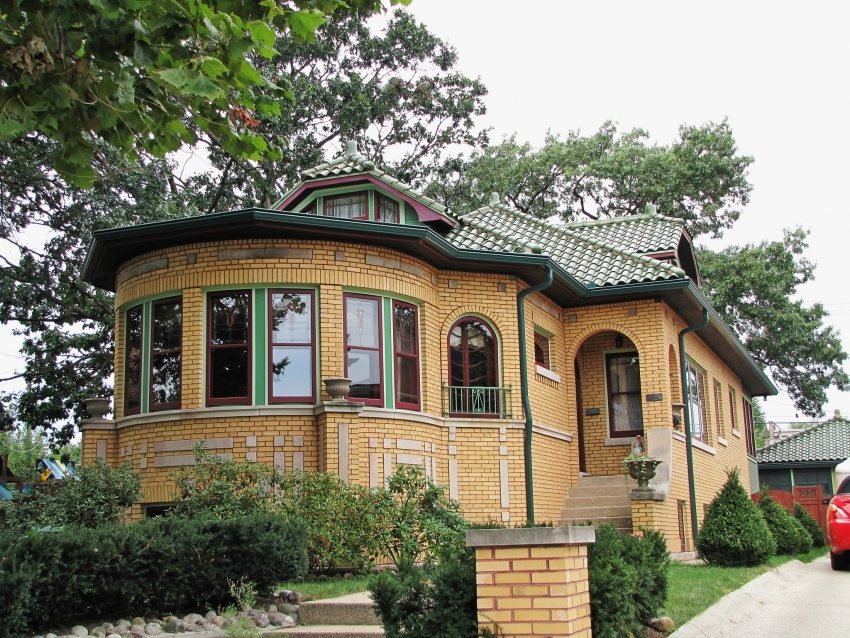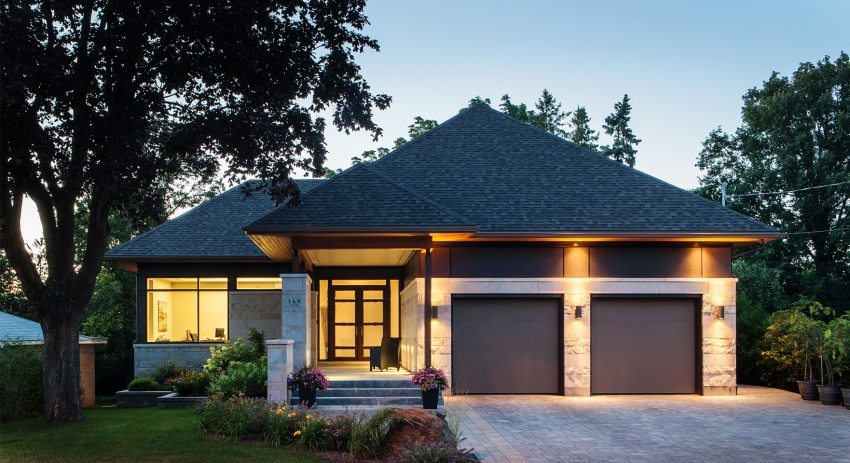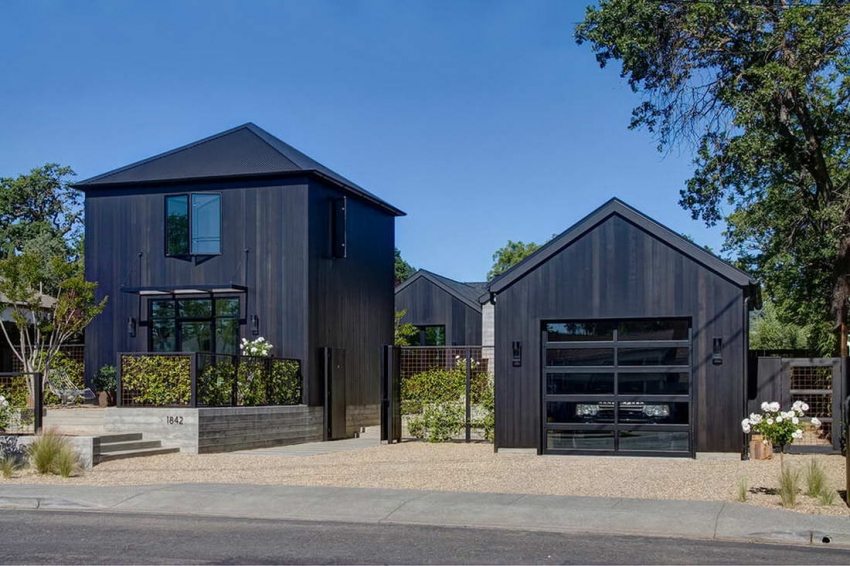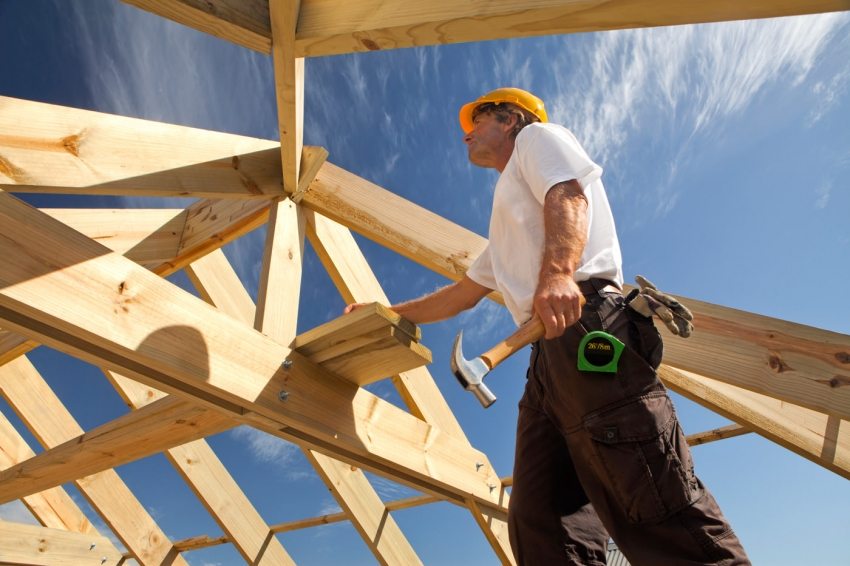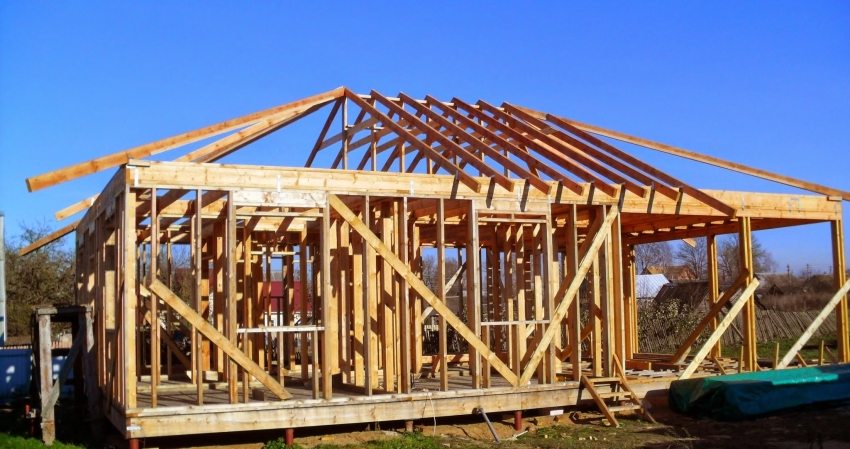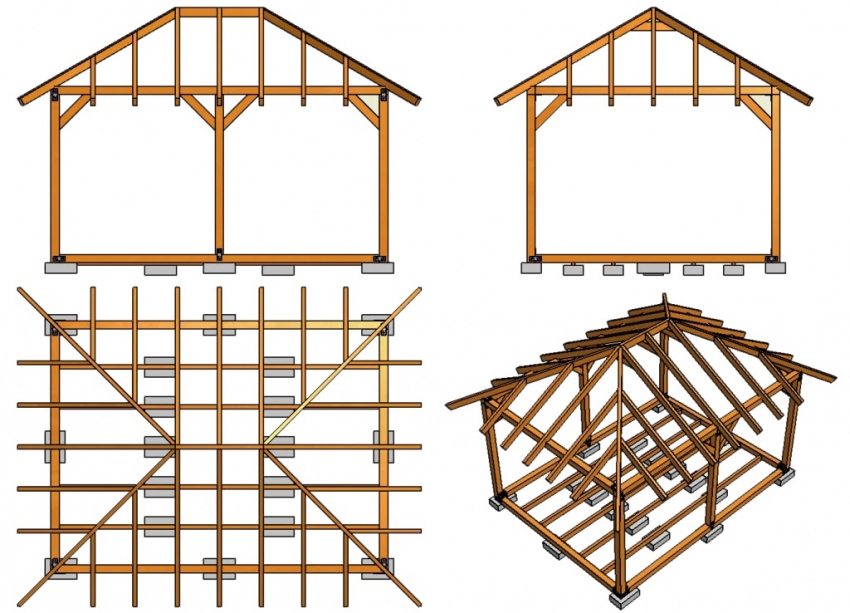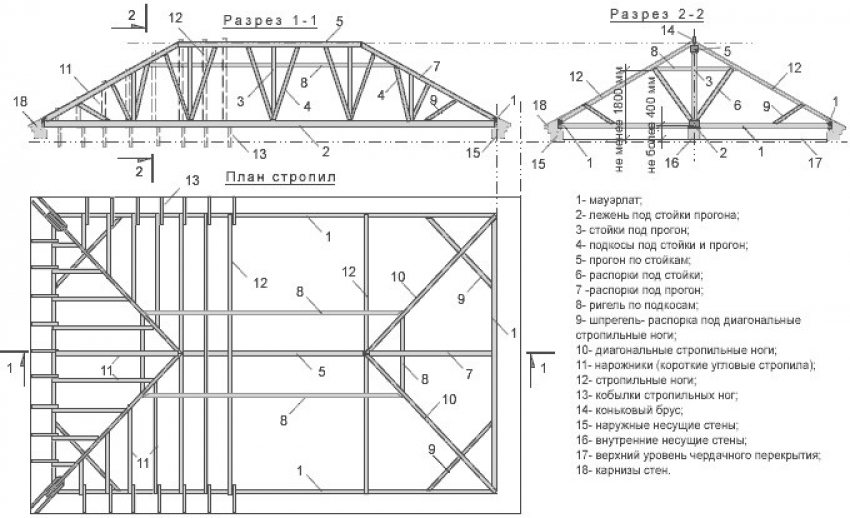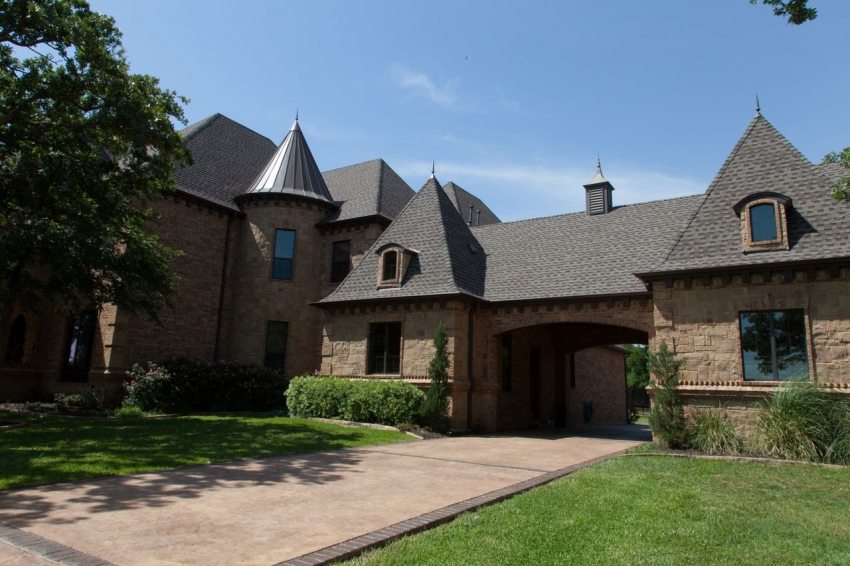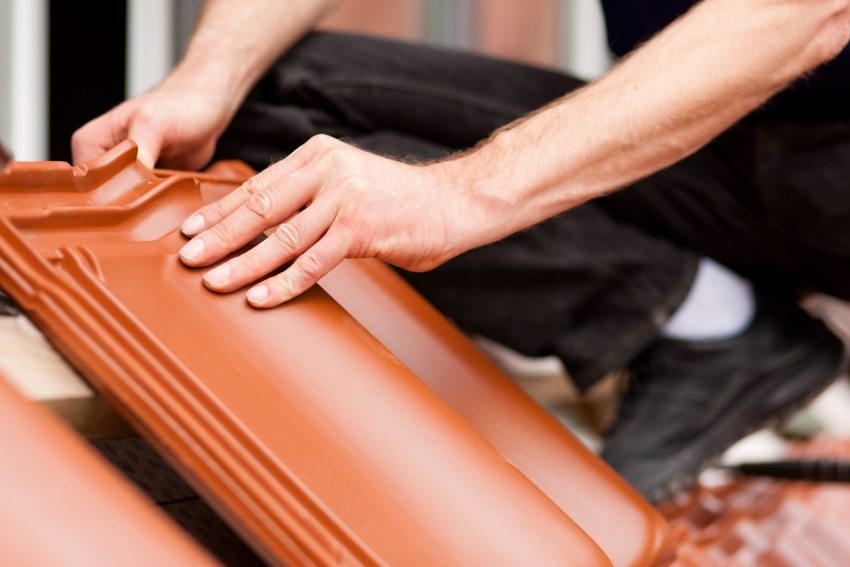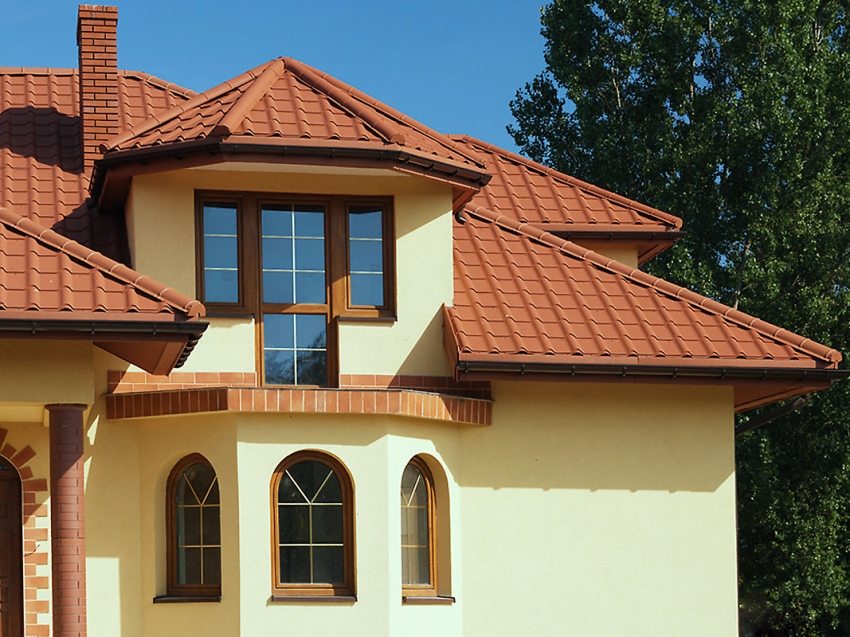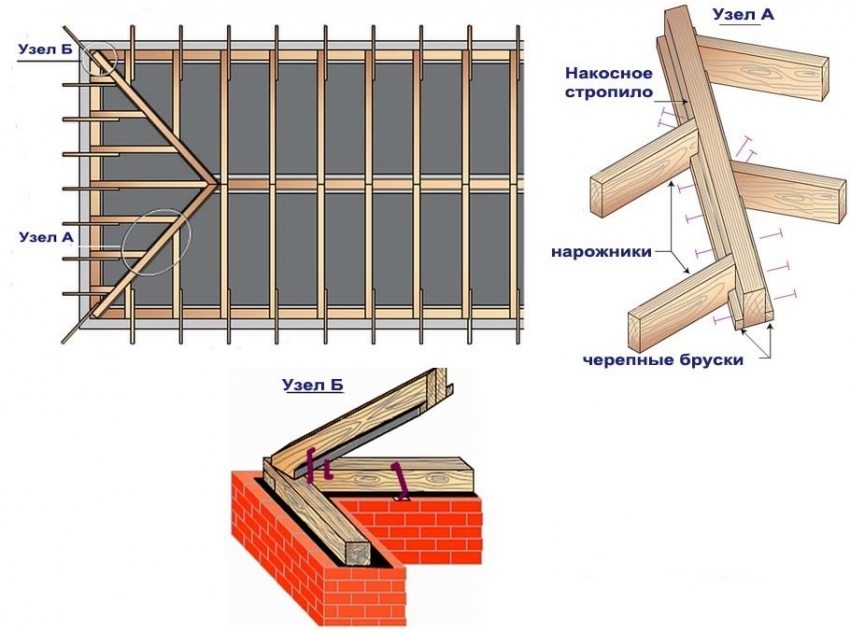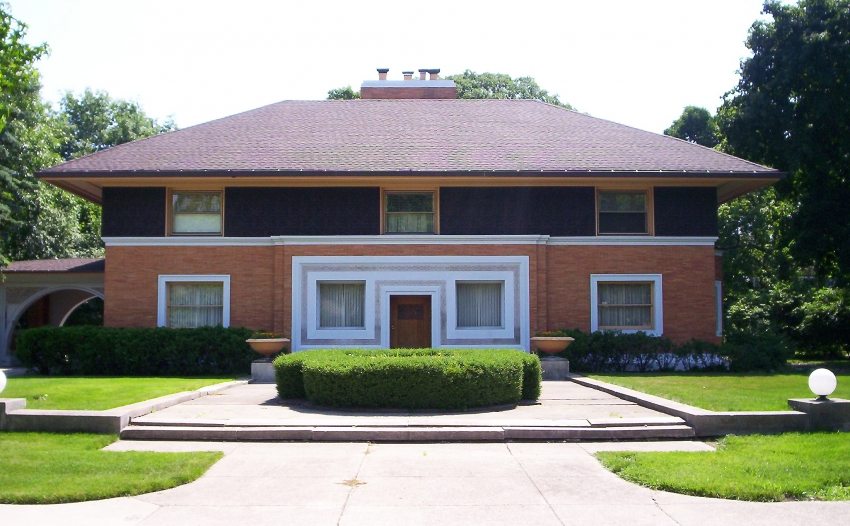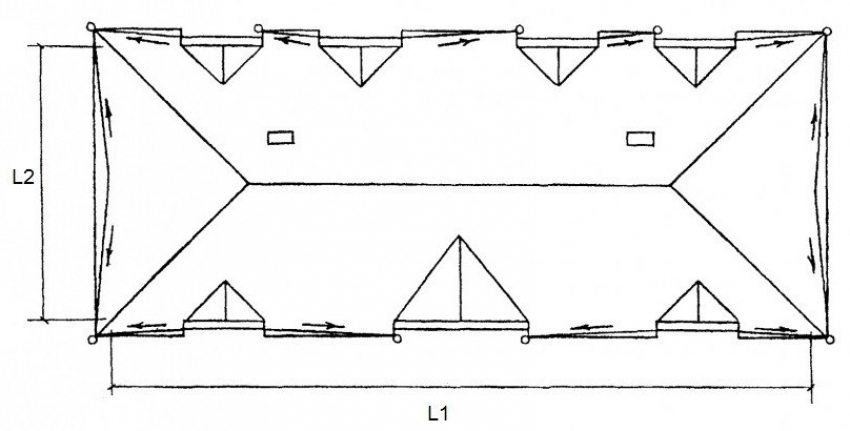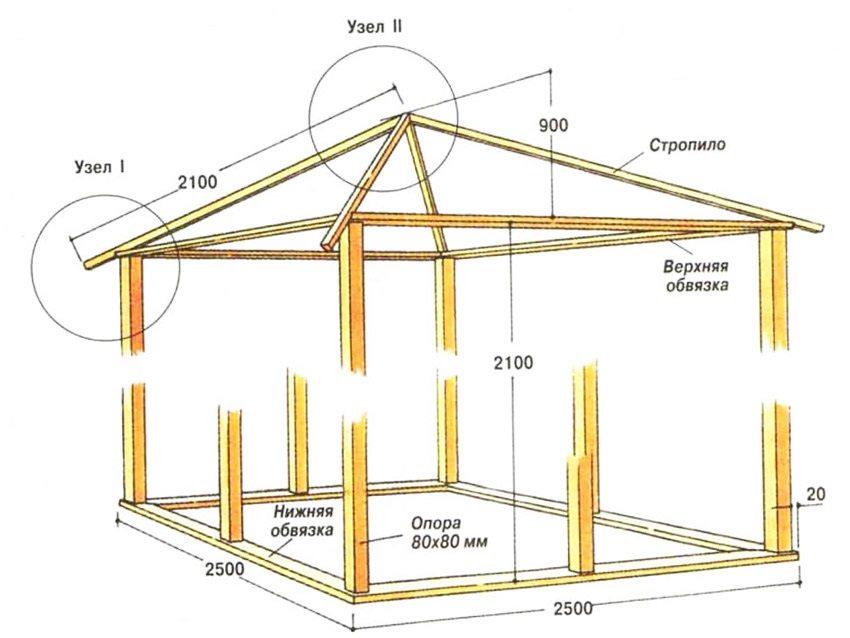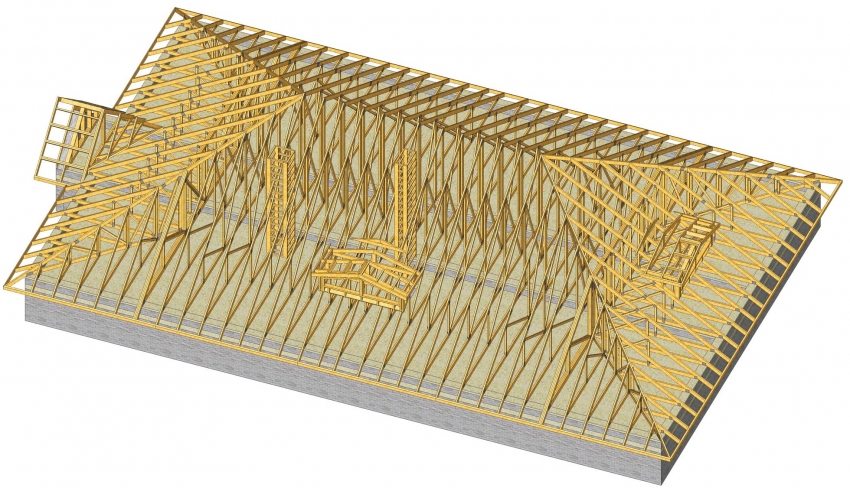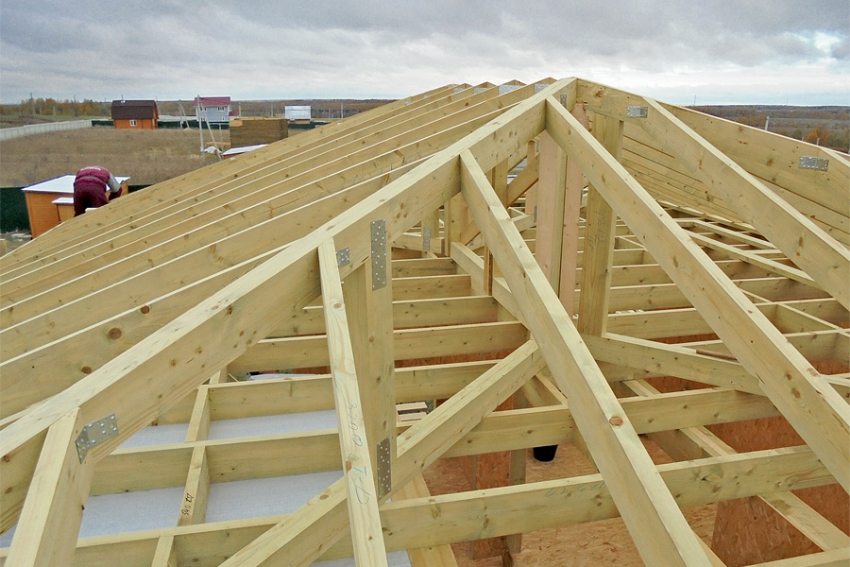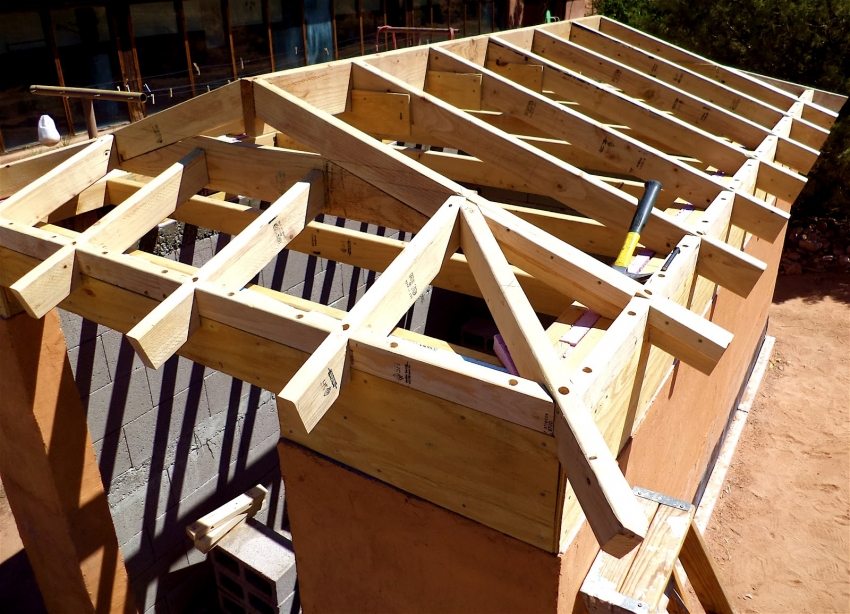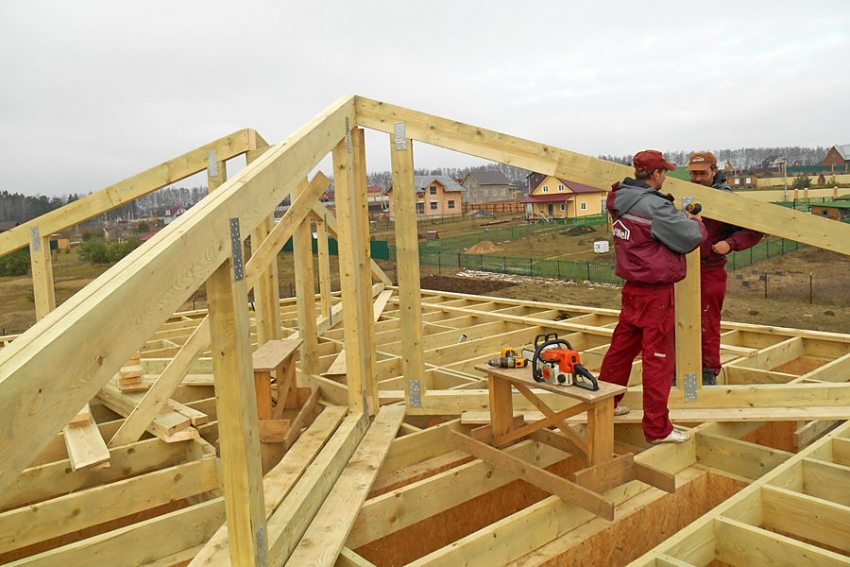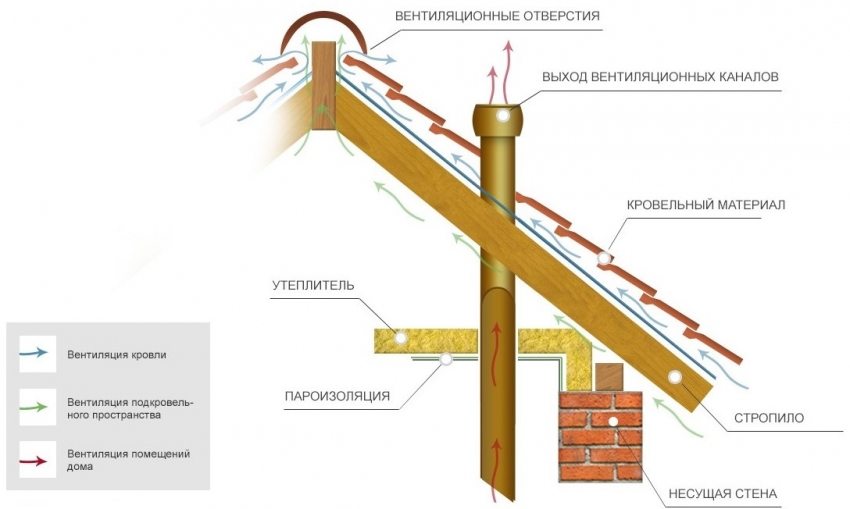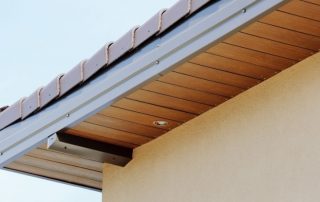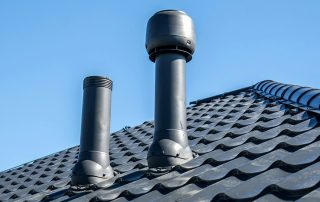Among roofs for a private house, hip roofs have good self-cleaning ability and withstand strong wind loads. In addition to excellent technical characteristics, the appearance of such structures is impeccable. However, the rafter system of the hip roof has a rather complex structure and requires the correct calculation of all components. The presence of a competent project and painstaking installation will be the key to a beautiful and sound design.
Content
- 1 Hip roofs: photos of structures of interesting design
- 2 The main advantages of a hip roof
- 3 Hip roof rafter system: main elements
- 4 Diagram of the rafter system of the hip roof
- 5 Hip roof rafter system with bay window
- 6 Do-it-yourself hip roofs: drawings and photos, sketches and design calculations
- 7 How to mount a do-it-yourself hip roof step by step: video installation
Hip roofs: photos of structures of interesting design
Hip roofs are a type of roof consisting of four slopes and, due to their design features, are highly resistant to strong gusts of wind. This is due to the fact that hips (inclined triangular slopes) are used instead of gables in houses with a hip roof, thanks to which the shape becomes more streamlined, and the roof itself is strong.
The absence of gables makes the height of a house with a hip roof visually smaller, however, in general, housing construction with such a roof looks organic. Photos of one-story houses with a hip roof indicate that often the space directly under the roof is used to equip a cozy attic room. To illuminate the attic, full-fledged window structures are located in the roof.
A photo of houses with a hip roof illustrates the neat external outlines of the roof, in which dormer windows are often equipped. This makes the roof colorful and interesting in terms of design. Gable roofs are usually used for large houses, the base of which forms a rectangle. If the perimeter of the house has a square shape, then another type of hip roof is used - hip roof.
The main feature of the hipped roof is that all of its slopes have the same shape of an isosceles triangle and an identical angle of inclination.All the faces of such a structure converge at one upper point. Hip roofs are also appropriate for houses with a regular polygon shape. How many sides are in the polygon, so many symmetrical slopes will be at the roof. From an architectural point of view, such designs are no less attractive.
Another subspecies of the hip roof is the semi-hip roof. This is a combination of a gable and a hip model in one design. To give the roof a streamlined shape, the pediment is covered with a small triangular slope (half hip), the length of which is shortened along the slope. This option contributes to the fact that the ridge element of the roof becomes inaccessible to the action of wind currents. When using the space under the roof as an attic, it is possible to equip full-fledged windows in the gable part.
Related article:
The rafter system of a half-hip roof: design and installation features. Calculations and stages of construction. The choice of insulation, insulation layer and roofing material. Algorithm for installation and finishing of a half-hip roof.
Hip roofs with a bay window look exceptional. Bay window roofs add romance and sophistication to all housing construction. You can find roofs with bay windows attached to the main structure or separately erected above the ledge of the walls. The main disadvantage of such roofs is the complexity in design and rather expensive installation.
Almost all modern roofing materials can be used to cover the hip structure: slate, corrugated board, metal tiles, ceramic and bituminous tiles and other materials. The roof covering is selected taking into account the slope of the roof, the characteristics of the climate of the region, the characteristics of the material. In addition, the durability, aesthetics and cost of the coating itself play an important role.
Note! The use of sheet roofing material as a covering of the tent structure will entail a fair amount of waste.
Getting acquainted with the design of the hip roof, you can find that it is quite difficult to coordinate all the slopes with the same slope with each other. Accurate calculations, competent design and theoretical advice from professionals are required. But, despite the complexity of the frame construction, hip roofs are undoubtedly popular among private developers.
The main advantages of a hip roof
In addition to the original design, hip roofs have a number of advantages that distinguish the structure favorably from other models:
- the absence of gables makes the structure invulnerable to strong wind loads. The smaller the slope of the roof slopes, the less impact the wind pressure has on the rafter system;
- the streamlined shape of all four slopes contributes to the stability of the structure to any type of precipitation;
- as for the efficiency of energy saving, such a structure is in many ways superior to gable roofs;
- insulating the hip roof is much easier, since the thermal insulation cake is located under the slopes. In models of roofs with gables - special insulation of the vertical facade is required, which is more exposed to wind force;
- the system of slant, central and extension rafters provides a reliable structure that is resistant to deformation under the influence of external loads;
- depending on the slope, there is the possibility of rational use of the space under the hip roof for the attic and the arrangement of windows in the roof.
The main disadvantages of four-slope models are the complexity of the structure of the rafter system of the hip roof and the impossibility of arranging the attic in models with a slight slope.However, with due study of the drawings of hip roofs and thought out to the smallest details of construction measures, the construction of such structures becomes a really feasible task.
Hip roof rafter system: main elements
The frame of the hip roof is a ridge beam and a system of various rafters. Taking into account the fact that the slopes and hips have a different slope, there are several types of rafter legs. The main components of the design include:
- corner rafters (slanting) - the main supporting structural elements located at the corners of the frame. Slant rafter legs have a smaller slope relative to other intermediate rafters;
- central rafters - they are attached to the ends of the ridge beam: there are three elements on each side. They are called center intermediate rafters;
- intermediate rafters - located between the central rafters, starting from the strapping and ending at the ridge;
- short rafters (rafters) - the elements are attached at one end to the mast rafters, the other to the strapping. Popular rafters differ in length, but have the same slope;
- ridge girder - a horizontally located crossbar, which serves as the upper support for the slant and central rafters;
- mauerlat - a bar fixed on top of the outer walls. It serves to evenly distribute the concentrated load of the rafter legs. Mauerlat is a kind of rafter system base and connects the roof frame to the walls of the house. Since the roof area is large, such an anchor allows the roof not to "fly away" in strong gusts of wind;
Note! When choosing the parameters of the Mauerlat, it is necessary to take into account the ability of the support bar to ensure the stability and reliability of the entire rafter structure.
- strut - an inclined beam used as a support for the rafters of a large span, taking horizontal loads. Using struts, it is possible to cover a significantly larger span and save the section of the main bearing beams. In the construction of hip roofs, the angle of inclination of the struts is 45 or 60 degrees;
- babaka - a vertical support on which the rafter legs rest;
- tightening - a wooden bar that acts as an additional support for the rafter legs and prevents them from moving apart. For tightening, a bar of a smaller section is usually used than for rafters;
- sprengel - horizontal elements laid diagonally in the corners of the walls. The sprengel acts as a support for the rack for the nesting rafters. Such an element is used when it is not technically possible to install the rack on the floor;
- lathing - a layer of small-section boards, which are laid perpendicularly over the rafters. Serves as a base for roofing. Sheathing boards are laid in small steps (approximately one board). In the places where the valley or cornice is located, the crate is made continuous;
- counter battens - elements installed on top and parallel to the rafters to the battens. They are used to create a ventilation gap between the battens, waterproofing and roofing material;
- filly - a small piece of board, with the help of which the rafter leg is lengthened to create a cornice overhang. It is designed to drain rain and melt water from the walls of the house, as well as to protect the basement and slopes from oblique rain.
In the photo of the rafter system of the hip roof, you can see that the ridge girder is located strictly in the center and parallel to the bearing walls of the house. In addition, the start and end of the run must be at the same distance from the end walls. This arrangement will ensure an even distribution of the load, and, consequently, the stability of the structure.
Diagram of the rafter system of the hip roof
Hip gable roofs surpass conventional gable models in construction complexity. This is due to the difficulty of accurately joining all four slopes at the required slope. These roofs have two large trapezoidal slopes and two end slopes in the form of a triangle. When forming the rafter system, the main difficulties arise in the device of the hip roof.
The project of a house with a hip roof takes into account that the slope of the slopes should be in the range from 10 to 60 degrees. The choice of the angle of inclination is influenced by the amount of precipitation, the material of the roof covering, and also whether the under-roof space will be used for the attic. In regions with a lot of precipitation, the slope should be at least 45 degrees.
The hip roof scheme must provide for the section shape, dimensions and exact location of all structural elements of the frame. In addition, in the drawings of the rafter system of the hip roof, the length of the ridge girder, the height of the roof, the angle of inclination of the slopes, the width of the spans, methods of strengthening the structure and the specifics of fastening the elements are reflected.
Considering that the rafter legs are of great length and are supporting for the handlers, they need reinforcement. To do this, use a sprengel, the beam of which is cut into the Mauerlat, and the support leg is supported with a stand. To strengthen the rafter system, the use of a wind beam is practiced. It is fixed on the inside of the central rafters diagonally, mainly from the windy side of the house.
In the case when the rafters have a length of more than 4.5 m, diagonal struts are used to strengthen them, the use of which allows you to choose a beam of a smaller section for the rafters. The braces rest against the puffs (floor beams), which do not allow the rafters to part. If the braces are attached closer to the ridge ledger, they can serve as a base for the attic ceiling sheathing.
Useful advice! The closer the tie beams are attached to the ridge girder, the more powerful the rafter system must be attached.
In the scheme of rafters of a hip roof, the expediency of using layered or hanging rafters, as well as the use of additional reinforcing elements, is justified. If during the calculations it turns out that the parameters of the timber do not correspond to the required load, it is possible to use glued or inlaid rafter beams. These modified elements are much more massive and can be longer.
If the house building does not have an intermediate bearing wall, then hanging rafter legs are used, which rest on only two supports (on two walls of the house). In this case, the rafters are subjected to compression and bending loads. Due to the fact that the rafter legs create a bursting force on the walls, a wooden tightening is used, which connects the rafters. Usually it is installed at the bottom at the base of the rafter legs.
When the structure has an intermediate load-bearing wall or middle support pillars, a layered rafter pattern is used. In this version, the rafters with one end rest on the outer walls, and for the middle part of the legs, the columns or the inner load-bearing wall are the support. With this design, the rafter elements work in bending, like a beam.
Compared to a roof that uses hanging rafters, the structure with layered rafter legs is lighter. The construction of such a roof uses less materials, which reduces construction costs. It is possible to use a combined rafter system in one structure. This happens when one part of the house has an internal load-bearing wall and the other does not. For a roof over such a structure, both rafters are used.
The scheme of rafters of a hip roof with an extension is used when it is necessary to increase the cornice. In this case, the rafter legs will rest against the floor beams. When installing a hip roof with the rafters resting on the floor beams, an element such as a Mauerlat can be completely excluded from the structural scheme. Instead, the use of wooden leveling pads is proposed.
Hip roof rafter system with bay window
Quite popular in private construction is the construction of walls of houses with bay windows (ledges). This is a very interesting architectural solution, however, the projects of such houses are distinguished by the complexity of the design and construction of the structure. A bay window can be erected not only during construction, but also attached to an existing building. The ledge can be single-storey or multi-storey.
It should be noted that the most difficult thing in the construction of houses of such an architectural form is the design and installation of a hip roof with a bay window. The basic rule is that the bay window roof should harmoniously support the main roof of the structure, forming a general style. It is very difficult to build a bay window, so not everyone decides to build such a house. The slightest inaccuracy in the calculations can lead to the fact that the design will be unreliable.
The shape of the roof for it depends on what shape the ledge has (rounded, multifaceted, rectangular). This can be a hip, multi-gable, gable structure or a hemispherical roof. Sometimes a steeple-shaped roof is erected over the bay window.
There are two versions of the roof over the bay window: an independent roof of the ledge or combined with the roof of the main structure. For the bay window rafter system, a material with a smaller section is used than for the rafter legs of the main roof structure. This is due to the fact that these elements will perceive less load.
The technology for laying the roof covering above the bay window is identical to the method for covering the main roof. It is recommended to use shingles, as a small area with several slopes requires a material that would leave a minimum amount of waste. This requirement is met by bituminous or ceramic tiles. For calculation metal tiles for a hip roof, you can use a special calculator.
When building roofs with a bay window, special attention should be paid to valleys. They are used in construction of two types - the upper valley bar and the lower one. One closes the unaesthetic sections, the other will run down sediments. In addition, professionals do not advise saving on fasteners (screws, nails, hairpins, plates). They must be purchased in the right quantity and of good quality.
Useful advice! To increase the reliability of problem areas of the hip structure with a bay window, a sealant and sealant should be used in these places.
You can find out about the features of the construction of the structure from the video of the installation of a hip roof with a bay window.
Do-it-yourself hip roofs: drawings and photos, sketches and design calculations
Before you start building a hip roof with your own hands, you need to complete the drawings and make the correct calculation of the entire structure. It would not be superfluous to seek help from a specialist who has experience in this area and will be able to optimally select the angle of inclination and calculate. Considering that the roof structure may contain broken lines and irregularities, it will be difficult to accurately calculate all the constituent elements.
Drawing and sketching tips
Before making a hip roof with your own hands, even the simplest design, you will need to develop a project for a hip roof with drawings and sketches.This will help determine the shape of the roof and make it possible to correctly calculate the required amount of materials for construction. To complete the design, you can use the following recommendations:
- the height, length, and width of the house should be measured. According to the data obtained, schematically depict the facade and the end of the house on a convenient scale. Several copies of such sketches must be made;
- when determining the optimal height of the hip roof in relation to the house and the slope of the roof slopes, it is necessary to display several options for the roof contour in one of the sketches. Next, you should choose the most successful one, and using the protractor, determine the angle of inclination of the slopes of the future structure;
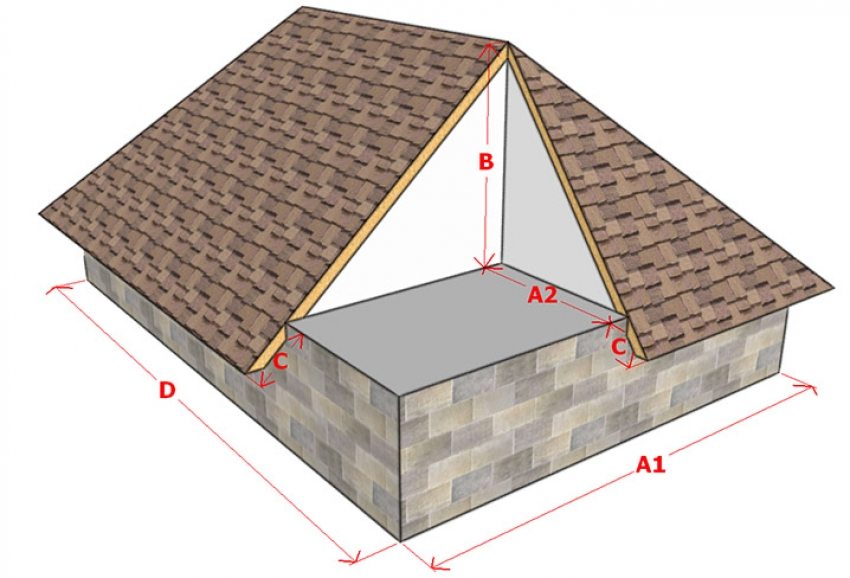
Hip roof project, where A1 - base width, A2 - foundation width, B - rise height, C - overhang length, D - base length
- the next step will be to apply the position of the layered rafters to the marking scheme - in these places we mark the points. We divide the length of the wall indicated in the diagram into equal segments - this will be the step between the beams. It can be from 40 cm to 2 m. But it must be borne in mind that quite often installed rafter legs will entail excessive consumption of material, and a large step between the rafters will cause the use of structural reinforcement elements;
- when determining the length of the ridge, it is necessary to take into account that the girder must connect the paired number of rafter legs. On one of the sketches, you need to mark equal segments from each edge of the wall;
- the resulting schemes are transferred to the general scheme, after which you can calculate the amount of material required. The length of the rafter legs is determined on the outside, based on the length of the eaves overhangs (about 50 cm).
Useful advice! For the roof structure to be strong and durable, it is necessary to purchase well-dried lumber.
By the number of rafter legs, you can calculate the number of fasteners. All nodules will use nails. For each rafter leg, there are two mounting angles. When storing material, you should make a small margin in case of damage to the material. If the house is made of bricks or blocks, you need to purchase a bar for the Mauerlat device.
Choosing the angle of inclination of the slopes
When determining the angle of inclination of the hip roof, the climatic conditions in which the construction is carried out should be taken into account. If the climate is hot, dry and windy, the slope should be minimal to prevent overheating and avoid additional stress. In areas with heavy snowfall, the slope is increased for unhindered snow melting.
In addition, when choosing the angle of the hip roof, one should take into account the roofing material, each type of which has restrictions on the slope of the slopes:
- slate - the coating is used with a roof slope from 13 to 60 degrees. If the angle of inclination is less than 13 degrees, then moisture will seep into the joints, and in winter - snow will fall. This will lead to a significant reduction in the life of the roof;
- ceramic tiles - the optimal slope for this material: from 30 to 60 degrees. When installing roof tiles with a slope of less than 25 degrees, measures should be taken to improve ventilation and waterproofing;
- metal tile - when laying this material, the maximum angle of inclination is not standardized, the minimum is 15 degrees;
- bituminous shingles - the coating is used for roofs with a slope over 12 degrees. The maximum angle of inclination is unlimited. The material perfectly repeats the shape of any surface;
- bituminous slate - sheets of this material are used with a slope of 5 degrees. There is no maximum value, however, the pitch of the lathing will depend on the angle of inclination, and with a slope of 5 to 10 degrees, you need to equip a continuous flooring;
- steel seam roofing - fits with slopes of 20 degrees. There is no maximum tilt angle limitation.
An increase in the angle of inclination increases the roof area, which will entail additional costs of building material. Therefore, if it is fundamentally important to save materials, then this should be taken into account when drawing up drawings.
Features of calculating the area of the hip roof
To determine the required amount of roofing material to cover the hip roof, it is necessary to calculate the area of the covered surface.
The calculation will require the following data:
- dormer windows and chimney pipes in the roof are taken into account, since their presence obliges to increase the consumption of roofing material;
- the length of the slope from the bottom of the ridge to the edge of the eaves overhang is determined;
- the calculation of the walls of the firewall, parapets, overhangs and other elements is performed;
- the calculation does not take into account the abutments of the canvases, standing folds, protruding elements of the bars.
Useful advice! If roll material or metal tiles will be used for the covering, when determining the surface area, it is necessary to reduce the length of the roof slopes by 70 cm.
To obtain accurate data on the roof area, you can seek help from specialists or use modern programs that will make the most accurate calculation. But if, nevertheless, you decide to do it yourself, it is necessary to conditionally divide the entire surface into separate elements, the area of which is easy to calculate mathematically, and then sum the obtained values.
The more accurately the area is determined, the lower the likelihood of acquiring unnecessary material and waste of finance. The amount of materials required for construction must be fixed at the stage of the project of a one-story house with a hip roof. The cost of these materials also includes the roofing, therefore, the cost of building the house as a whole depends on the correct calculation of the roof surface area.
To calculate the area, you must use the hip roof plan. You should also take into account the technical characteristics of the roofing (thickness, length) and methods of its installation. The thickness of the material affects the weight of the coating, and knowing the length and width of the material can be used to position it with the least amount of waste and joining lines.
For clarity, you can analyze the use of ceramic or flexible tiles as roofing material. Ceramic tiles - the material is heavy and weighs 5 times more than flexible. For the installation of shingles, a rafter system and frequent lathing are not required, but solid plywood or other material must be laid under it. Therefore, in order to determine the cost of the entire construction and choose the most profitable material, it is necessary to perform the calculation of the hip roof.
The total cost of construction, no doubt, will be influenced by the area of the hip roof, but at the same time, the complexity of the construction of the structure itself should be taken into account, especially when it comes to arranging the attic room. The complexity of the calculation will be affected by such elements as dormers, ventilation openings, chimneys, etc.
For example, you can calculate the area of a hipped roof. With a roof drawing, calculations are much more convenient and the required values will be more accurate. The diagrams show that the base for the roof is a rectangle, two slopes are an isosceles triangle, the other two are trapezoids.
In this case, the tangent of the angle of inclination of the triangular face is equal to the ratio of h (height of the roof) to ½ of the value of b (length of the base of the triangle). So, the height of the roof is determined by the expression:
h = (b tan α) / 2.
The length of the side rafter leg (e) can be determined using the angle of inclination:
e = b / 2 cos α.
Using the Pythagorean Theorem, you can determine the length of the rafter rafter legs (d):
The total area of the entire roof is calculated by summing the areas of all the constituent elements of the surface of the hip roof, namely, four triangles and two rectangles:
S = 4 (eb / 2) +2 (a-b) e = 2e (b + a-b) = 2ea.
If you want to calculate the area of a hip roof for a square house, then its value will be equal to the sum of the areas of four triangular slopes.
Hip roof area calculator
In view of the fact that not everyone can independently calculate all the parameters of the roof, the websites of companies specializing in the construction of roofs and the sale of roofing materials suggest using an online calculator. With its help, you can find out the exact amount of lumber, insulation and roofing materials, as well as calculate the length and section of the rafters for the structure of the selected type.
Using an online calculator with drawings and diagrams to calculate the hip roof, you can determine how optimal the slope of the slopes is in relation to a particular roof covering, whether the cross-section of the timber is capable of withstanding the current wind and snow loads on the rafter system in your region.
Before calculating the hip roof using the program, you must fill in the proposed fields of the calculator: the length and width of the base, the slope of the roof, the length of the side and end overhangs, the width, thickness and pitch of the sheathing board, indicate the type of wood and the pitch for the rafter legs. In addition, data on the region and type of terrain are entered to calculate the load.
Useful advice! While working in the program, pay attention that there is a "?" Icon opposite each filled field. By clicking on it, you can find explanations for a specific input parameter.
After processing the entered data with an online calculator, you will receive information about the compliance of the slope you specified with the norms of the roofing used. If a discrepancy is found, the program will offer replacement options. In addition, you will receive data on the lifting height, the length of the hip roof ridge, the weight of the roof covering, the amount of roll material taking into account the length and width of the roll, as well as the required overlap during installation.
The calculator's conclusions also include the surface area of the roof (this will include the sum of the areas of all slopes, including overhangs of the required length), the amount of roofing and under-roofing material that will be required to erect the roof. The calculated value of the maximum load on the rafter system takes into account the roof structure, the weight of the roofing cake, and the entered data on snow and wind loads.
In addition, the program will calculate the rafter system of the hip roof: it will give information about the number and dimensions of side and diagonal rafters, and also suggest the recommended size of the minimum section for the rafter system, the choice of which will provide the structure with proper strength.
By using the calculator's data on the optimal number of rows and battens, you can avoid possible waste of material, as well as time-consuming unnecessary trimming of lumber. In addition, you will receive information on the number of boards in cubic meters and kilograms.
Using the program for calculating a hip roof, you will not only save time and money, but also receive practical recommendations based on the norms of SNiP "Loads and Impacts" and TKP 45-5.05-146-2009 (Wooden structures. Building design standards).
How to mount a do-it-yourself hip roof step by step: video installation
Assembling the rafter system of a hip roof is not an easy task, but with strict adherence to the project and the practical advice of professionals, you can cope with the construction yourself. The key to high-quality installation is the most correct calculation and an accurate scheme, following which you can make the correct cuts of the rafter legs and install all the structural elements. For example, you can watch the video of the installation steps by finding it on the Internet.
Instructions for the construction of a hip roof with your own hands
Before making a hip roof yourself, you should familiarize yourself with useful recommendations, adhering to which you will not have to doubt the reliability of the structure:
- the intermediate rafter legs have a steeper slope than the slant rafters. In this regard, a board with parameters of at least 5x15 cm is used for them;
- fixation of short rafters is done not to the ridge girder, but to the nipple elements. The angles of inclination of the short and intermediate rafter legs coincide;
- lumber used for ridge girders and rafter legs must have an identical cross section. It is when this rule of construction is observed that the proper strength will be ensured. Otherwise, the probability of deformation is high;
- intermediate rafters are attached to the edge of the ridge beam and to the top of the harness;
- the height of the hip roof can be any, but if the slope is very slight, you should use additional support racks;
- in order to extend the life of the hip structure, it is necessary to use sawn softwood, pre-dried and free from defects in the form of knots and cracks. In addition, before starting work, all wooden elements are treated with antiseptic compounds.
Marking the future structure
The construction of a hip roof begins with the marking of the object.
Step 1. From the side of the end of housing construction, it is necessary to outline an axis along the upper trim of the walls.
Step 2. Next, you need to determine half the thickness of the ridge girder and outline the location of the first element of the roof truss system.
Useful advice! To avoid errors when marking the object, it is recommended to use a special measuring rod, on which all the required dimensions will be marked. It can be cut, for example, from a strip of plywood. Recommended rail width 5 cm.
Step 3. Attach the strip with one end to the marked line, and place the other along the side wall. So you can outline the point of location of the intermediate rafter leg.
Step 4. To determine the length of the rafter overhang, it is necessary to place the beam with one end on the outer corner, and the other on the roof overhang.
Step 5. To determine the location of the central rafter leg, it is necessary to move the marker strip to the edge of the side wall and fix the location of the central element of the rafter system.
This procedure should be applied to all four corners of the building. Thus, the places for the installation of intermediate rafters and the ends of the ridge girder will be outlined.
Calculation of the rafter system
After marking, it is necessary to calculate the rafter system.
Step 1. With the help of the rail, it is necessary to determine the horizontal projection of the intermediate rafter leg. Find the appropriate roof slope for your application from the standard table and multiply the values.
Step 2. Measure the length of the rafter leg, while the measurement should be taken along the lower line from the sampling point on the ridge run to the sampling at the base of the leg.
Step 3. To determine the length of the overhang, it is necessary to multiply the value of the horizontal projection of the rafter by the correction factor from the table of proportions.
Table of proportions and correction factors:
| Ukbosom of the roof slope | Coefficient for corner rafters | Coefficient for intermediate rafters |
| 3:12 | 1,016 | 1,031 |
| 4:12 | 1,027 | 1,054 |
| 5:12 | 1,043 | 1,083 |
| 6:12 | 1,061 | 1,118 |
| 7:12 | 1,082 | 1,158 |
| 8:12 | 1,106 | 1,202 |
| 9:12 | 1,131 | 1,250 |
| 10:12 | 1,161 | 1,302 |
| 11:12 | 1,192 | 1,357 |
| 12:12 | 1,225 | 1,414 |
Useful advice! When calculating, you can use the Pythagorean Theorem, in which c² = a² + b², where a and b are respectively vertical and horizontal projections.
Step 4. Next, you need to calculate the corner rafters. To attach the rafter legs to the ridge beam, oblique cuts are made at the ends of these elements. In turn, the ridge girder also has a double bevel, thanks to which the corner rafters are securely attached to it.
The calculation of the rafters is performed in the following sequence:
- from one of the corners of housing construction, the length of the rafter leg is determined;
- a projection is calculated, the value of which is equal to the sum of squares, the projection of the central rafters;
- the resulting number is multiplied by the correction factor from the table. This will be the length of the roof rafter.
Installation of rafter legs
Next, the rafter legs are installed.
Step 1. First, a ridge bar is installed, which is fixed on the support posts. The elements are fixed to the central beam by installing struts.
Step 2. When installing the slant rafter legs, check that the length of all elements is identical. Carefully join the hips, rafters and ridge bar together.
Step 3. After the foot legs are installed, you should proceed with the installation of ordinary rafter legs, which are positioned in increments of about 60 cm. The ordinary rafters are fixed to the Mauerlat and the ridge by cutting. To make the fastening reliable, use ties and crossbars.
Useful advice! When installing ordinary rafters, avoid their contact with the pins that secure the Mauerlat to the ends of the walls.
Step 4. Further, short rafters (rafters) are attached to the rafter legs. The rafters will be connected to the Mauerlat by means of extension elements. The position of ordinary and outdoor rafters should be perpendicular to the ridge bar.
Strengthening the structure of the rafters of the hip roof
There are several options for strengthening the rafter structure:
- at the corners of the structure, trusses with a vertical rack are diagonally attached, which will act as an additional support for the rafters. The sprengel is fixed to the Mauerlat;
- racks are placed on the tightening board, which will be the supports for the intermediate rafter legs;
- if the rafter rafter is long, use glued or stacked beams for its manufacture.
Ventilation device
An important stage in the construction of a hip roof is the ventilation device. The roof is exposed to destructive effects not only from the outside, but also from the inside, where moisture condensation can occur. This is due to the temperature difference between the outer and inner surface of the roof. High-quality ventilation of the under-roof space will preserve the roof surface for many years.
To ensure adequate ventilation of the space under the roof, it is necessary to arrange a hole in the windscreen for air intake. It should be located a short distance from the ridge run. When used for winding a tree, it is laid with a gap of up to 3 mm. In the case of using plastic material, perforation is practiced.
For those cases when the wind protection of the roof is mounted without a gap, ordinary ventilation grilles with a diameter of 50 cm can be cut into it. They should be placed along the entire length of the wind protection at a distance of about 80 cm from each other. After completing these works, you can start arranging insulation, waterproofing and laying the roofing material.
The device of the hip structure is a technically complex and painstaking process. It is worth doing the work if you have enough time, experience and knowledge in this area. Any inaccuracy can lead to unreasonable consumption of materials and higher construction costs.If you doubt your abilities, it would be appropriate to seek help from real professionals.
